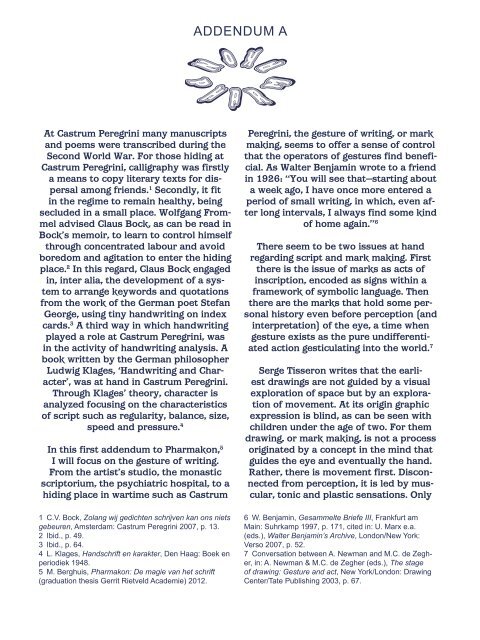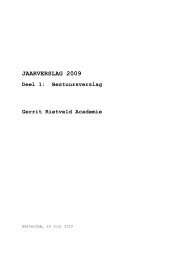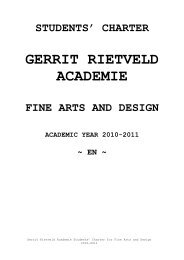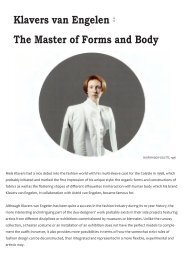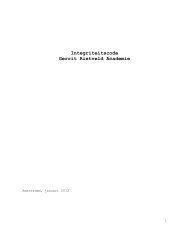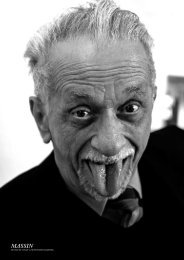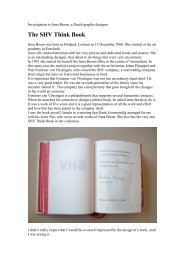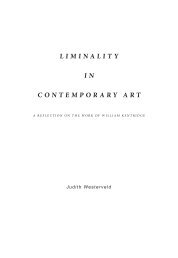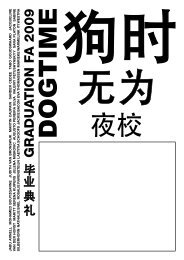ADDENDUM A - Gerrit Rietveld Academie
ADDENDUM A - Gerrit Rietveld Academie
ADDENDUM A - Gerrit Rietveld Academie
Create successful ePaper yourself
Turn your PDF publications into a flip-book with our unique Google optimized e-Paper software.
<strong>ADDENDUM</strong> A<br />
At Castrum Peregrini many manuscripts<br />
and poems were transcribed during the<br />
Second World War. For those hiding at<br />
Castrum Peregrini, calligraphy was firstly<br />
a means to copy literary texts for dispersal<br />
among friends. 1 Secondly, it fit<br />
in the regime to remain healthy, being<br />
secluded in a small place. Wolfgang Frommel<br />
advised Claus Bock, as can be read in<br />
Bock’s memoir, to learn to control himself<br />
through concentrated labour and avoid<br />
boredom and agitation to enter the hiding<br />
place. 2 In this regard, Claus Bock engaged<br />
in, inter alia, the development of a system<br />
to arrange keywords and quotations<br />
from the work of the German poet Stefan<br />
George, using tiny handwriting on index<br />
cards. 3 A third way in which handwriting<br />
played a role at Castrum Peregrini, was<br />
in the activity of handwriting analysis. A<br />
book written by the German philosopher<br />
Ludwig Klages, ‘Handwriting and Character’,<br />
was at hand in Castrum Peregrini.<br />
Through Klages’ theory, character is<br />
analyzed focusing on the characteristics<br />
of script such as regularity, balance, size,<br />
speed and pressure. 4<br />
In this first addendum to Pharmakon, 5<br />
I will focus on the gesture of writing.<br />
From the artist’s studio, the monastic<br />
scriptorium, the psychiatric hospital, to a<br />
hiding place in wartime such as Castrum<br />
1 C.V. Bock, Zolang wij gedichten schrijven kan ons niets<br />
gebeuren, Amsterdam: Castrum Peregrini 2007, p. 13.<br />
2 Ibid., p. 49.<br />
3 Ibid., p. 64.<br />
4 L. Klages, Handschrift en karakter, Den Haag: Boek en<br />
periodiek 1948.<br />
5 M. Berghuis, Pharmakon: De magie van het schrift<br />
(graduation thesis <strong>Gerrit</strong> <strong>Rietveld</strong> <strong>Academie</strong>) 2012.<br />
Peregrini, the gesture of writing, or mark<br />
making, seems to offer a sense of control<br />
that the operators of gestures find beneficial.<br />
As Walter Benjamin wrote to a friend<br />
in 1926: “You will see that—starting about<br />
a week ago, I have once more entered a<br />
period of small writing, in which, even after<br />
long intervals, I always find some kind<br />
of home again.” 6<br />
There seem to be two issues at hand<br />
regarding script and mark making. First<br />
there is the issue of marks as acts of<br />
inscription, encoded as signs within a<br />
framework of symbolic language. Then<br />
there are the marks that hold some personal<br />
history even before perception (and<br />
interpretation) of the eye, a time when<br />
gesture exists as the pure undifferentiated<br />
action gesticulating into the world. 7<br />
Serge Tisseron writes that the earliest<br />
drawings are not guided by a visual<br />
exploration of space but by an exploration<br />
of movement. At its origin graphic<br />
expression is blind, as can be seen with<br />
children under the age of two. For them<br />
drawing, or mark making, is not a process<br />
originated by a concept in the mind that<br />
guides the eye and eventually the hand.<br />
Rather, there is movement first. Disconnected<br />
from perception, it is led by muscular,<br />
tonic and plastic sensations. Only<br />
6 W. Benjamin, Gesammelte Briefe III, Frankfurt am<br />
Main: Suhrkamp 1997, p. 171, cited in: U. Marx e.a.<br />
(eds.), Walter Benjamin’s Archive, London/New York:<br />
Verso 2007, p. 52.<br />
7 Conversation between A. Newman and M.C. de Zegher,<br />
in: A. Newman & M.C. de Zegher (eds.), The stage<br />
of drawing: Gesture and act, New York/London: Drawing<br />
Center/Tate Publishing 2003, p. 67.
later is drawing guided by the eye. For<br />
young children, Tisseron writes, marking<br />
gestures are “a way for the child to stage<br />
the mother’s coming and going—really<br />
her frequent absences—so as to tame and<br />
master the experience in the imaginary as<br />
an early form of kinetic symbolization.” 8<br />
Opened and closed by the mark, the<br />
inscriptive game, both motional and<br />
emotional, enables an active control over<br />
separation anxiety while unlocking the<br />
child’s independence.<br />
Drawing is close to writing, perhaps closer<br />
to writing than to painting. For instance,<br />
a painting usually demands to be viewed<br />
vertically, while drawings and writings are<br />
best viewed flat. Walter Benjamin writes<br />
in this regard: “We might say that there<br />
are two sections through the substance<br />
of the world: the longitudinal section of<br />
painting and the transverse section of<br />
certain graphic works. The longitudinal<br />
seems representational—it somehow contains<br />
things; the transverse section seems<br />
symbolic—it contains signs.” 9<br />
The use of symbolic signs in drawing presupposes<br />
a direct connection to thought.<br />
A drawing is a record of the workings<br />
of thought embedded in the drawing. In<br />
that sense the drawing is the connection<br />
between thought and action. The murmurings<br />
of the mind are materialized in the<br />
markers of an action. Drawing as an investigation<br />
of thought, rather than an investigation<br />
of observation. 10 The impulse<br />
to draw is not to capture appearance so<br />
much as a demand to animate thought.<br />
What about writing in a graphic form,<br />
‘graphic work’ as Benjamin describes<br />
it, in between drawing and writing, suspended<br />
between gesture and thought?<br />
German writer Robert Walser tried to<br />
solve writer’s block when he started “to<br />
jot in pencil, to sketch, to dilly-dally.” 11 In<br />
graphic works, manuscripts that appeal to<br />
the eye as a textual image, the sign placing<br />
and the gesticulating of the hand and<br />
arm could—in a perfect equilibrium—lead<br />
to one subject, one body. Its own enjoyment<br />
realizes that this body, this enjoyment<br />
comes into meaning directly from<br />
itself. 12<br />
What comes first, action or thought? Richard<br />
Serra said in an interview: “Anything<br />
you can project as expressive in terms<br />
of drawing—ideas, metaphors, emotions,<br />
language structures—results from the act<br />
of doing.” 13 With the young child in mind,<br />
Tisseron gives the same answer. In the<br />
act of tracing the child creates a game<br />
and the practice of this game produces<br />
meaning. This is what could well be the<br />
meaning of rewriting texts. Creating a<br />
meaning in action, and deducting rules<br />
from action while in action. Reversing the<br />
usual order where formulated intentions<br />
lead to expression, rather the work becomes<br />
thought that thinks itself through<br />
the material. Through the gesture of writing<br />
or drawing, through practice, a meaningful<br />
method surfaces. It might then<br />
attract—with magnetic power—literature,<br />
art, well-being, some kind of home again.<br />
Marieke Berghuis, September 2012<br />
8 S. Tisseron, ‘All Writing Is Drawing: The Spatial Development<br />
of the Manuscript’, Yale French Studies 1994-84,<br />
p. 33.<br />
9 W. Benjamin, ‘Painting and the Graphic Arts’, in: The<br />
work of art in the age of its technological reproducability<br />
and other writings on media, Cambridge: Belknap 2008,<br />
p. 219.<br />
10 M. Manders, On Drawings, http://www.markmanders.<br />
org/texts/english/06/.<br />
11 W. Morlang, ‘Im Tarnzauber der Mikrographie’, in: Du.<br />
Zeitschrift für Kultur, 2002-730, p. 58, cited in: U. Marx<br />
e.a. (eds.), Walter Benjamin’s Archive, London/New York:<br />
Verso 2007, p. 50.<br />
12 J. Fisher, ‘On drawing’, in: A. Newman & M.C. de<br />
Zegher (eds.), The stage of drawing: Gesture and act,<br />
New York/London: Drawing Center/Tate Publishing 2003,<br />
p. 220.<br />
13 Cited in: E. Dexter, Vitamin D: New perspectives in<br />
drawing, London/New York: Phaidon 2005, p. 7.


